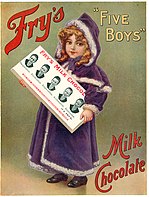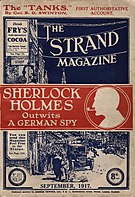J. S. Fry & Sons
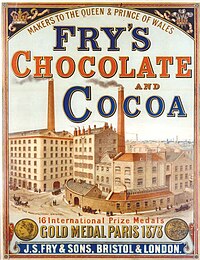 Advertisement for the 1878 Paris Exposition | |
| Formerly |
|
|---|---|
| Company type | Private (1761–1919) |
| Industry | Confectionery |
| Founded | 1761 in Bristol |
| Founder | Joseph Fry |
| Defunct | 2010 |
| Fate | Merged with Cadbury Brothers in 1919. Loss of operational independence in 1967. Original factory closed 2011. |
| Headquarters | , |
Key people | Joseph Storrs Fry II |
| Products | Chocolate |
| Brands | |
| Parent | Cadbury (1919–2010) |
J. S. Fry & Sons, Ltd., better known as Fry's, was a British chocolate company owned by Joseph Storrs Fry and his family. Beginning in Bristol in 1761, the business went through several changes of name and ownership, becoming J. S. Fry & Sons in 1822. In 1847, Fry's produced the first solid chocolate bar.[1][2][3] The company also created the first filled chocolate sweet, Cream Sticks, in 1853.[1] Fry is most famous for Fry's Chocolate Cream, the first mass-produced chocolate bar, which was launched in 1866, and Fry's Turkish Delight, launched in 1914.[1]
Fry, alongside Cadbury and Rowntree's, was one of the big three British confectionery manufacturers throughout much of the 19th and 20th centuries, and all three companies were founded by Quakers.[4][5] The company became a division of Cadbury in the early 20th century. The division's Somerdale Factory near Bristol was closed after the 2010 takeover of Cadbury's by Kraft Foods Inc.[6][7]
History
[edit]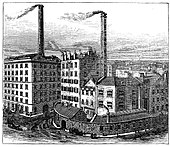
Joseph Fry, a Quaker, was born in 1728. He started making chocolate around 1759. In 1761, Fry and John Vaughan purchased a small shop from an apothecary, Walter Churchman, and with it the patent for a chocolate refining process.[5][8] The company was then named Fry, Vaughan & Co. In 1777 the chocolate works moved from Newgate Street to Union Street, Bristol. Joseph Fry died in 1787 and the company was renamed Anna Fry & Son. In 1795 Joseph Storrs Fry assumed control of the company. He patented a method of grinding cocoa beans using a Watt steam engine, and as a result, factory techniques were introduced into the cocoa business.[2]
In 1803, Anna Fry died and Joseph Storrs Fry partnered with a Dr. Hunt. The business was renamed Fry & Hunt. In 1822 Hunt retired and Joseph Storrs Fry took on his sons Joseph, Francis and Richard as partners: the firm was renamed J. S. Fry & Sons. The company became the largest commercial producer of chocolate in the UK. In 1835, Joseph Storrs Fry died and his sons took full control.
In 1847, the Fry's chocolate factory on Union Street, Bristol, moulded a chocolate bar suitable for large-scale production.[1][3] The firm began producing the Fry's Chocolate Cream bar in 1866.[1] Although cacao being consumed in solid form was not unheard of,[9] Fry's is considered the first chocolate bar suitable for widespread consumption.[2][3][10] Over 220 products were introduced in the following decades, including the UK's first chocolate Easter egg in 1873 and Fry's Turkish Delight (or Fry's Turkish bar) in 1914.[11] In 1896, the firm became a registered private company, run by the Fry family, with Joseph Storrs Fry II, grandson of the first Joseph Storrs Fry, as the chairman.[12]
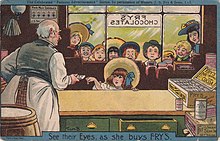
In 1881, an employee of Fry's, H. J. Packer, established his own chocolate business in Bristol. At its eventual home in Greenbank, Bristol, Packer's Chocolate continued to provide local competition for Fry's until 2006, under various owners and brands, from Bonds through to Famous Names and Elizabeth Shaw.[13]
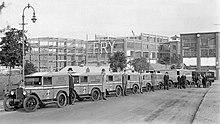
Near the start of World War I, the company was one of the largest employers in Bristol. Joseph Storrs Fry II died in 1913. In 1919 the company merged with Cadbury's chocolate and the joint company was named British Cocoa and Chocolate Company. After the merger, the Frys held 45.44% of the company's ordinary shares, as well as chairmanship and four seats on the company board.[14] Under Egbert Cadbury the Fry's division began from 1923 to move to Somerdale, Keynsham, just outside Bristol. The Fry family's representation on the company board decreased as British Cocoa and Chocolate Company expanded operations and opened factories in other countries. By the time Cadbury merged with Schweppes in 1969, only one Fry family member remained on the thirteen-seat company board, and the family held just over 10 percent of the ordinary shares.[14]
After 1981, the name Fry's was no longer in use at Somerdale; however, the factory was still a major producer of Cadbury products.[citation needed]
In October 2007, Cadbury announced plans to close the Somerdale plant, the historic home of the Fry's Factory, by 2010 with the loss of some 500 jobs. In an effort to maintain competitiveness in a global marketplace, production was to be moved to a new factory in Poland. Another motivational factor was the high value of the land. Labour MP for Wansdyke, Dan Norris, said, "News of the factory's closure is a hard and heavy blow, not just to the workforce, but to the Keynsham community as a whole".[15]
In February 2010, following the takeover of Cadbury plc by Kraft Foods, the closure was controversially confirmed to take place in 2011; Kraft had specifically agreed during the takeover battle to keep the site open. There was widespread outrage in the press and later a House of Commons Select Committee investigation into the affair.[16]
Archives
[edit]Records relating to both the business and the family are held at Bristol Archives (Ref. 38538). Some records concerning the role of J. S. Fry & Sons within Cadbury are held with the Mondelez International repository at Cadbury's UK headquarters in Bournville.[17]
In popular culture
[edit]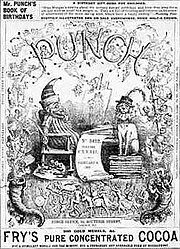
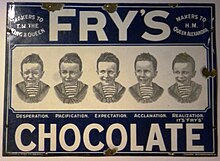
On the BBC television programme Being Human, an old Fry's Cocoa billboard hangs prominently on the side of the B&B where the main characters reside in Series 3–5. The billboard is a nod to the show's original Bristol location.[18]
In April 2020, an original enamel advertising sign with the distinctive "five boys" trademark design was featured on BBC's Antiques Roadshow and was valued at £1,000-£1,500.[19] The distinctive "five boys" design expressing "Desperation, Pacification, Expectation, Acclamation and Realisation "It's Fry's" references Queen Alexandra, indicating a production date before her death in 1925. On a tour of the Fry's Bristol factory when in his eighties, Lindsay Poulton, the boy featured in the design, recalled that his father had induced him to cry, for the first photograph, "Desperation", by wrapping an ammonia-soaked cloth around his neck.[20]
See also
[edit]- Fry's Chocolate Cream
- Fry's Turkish Delight
- Crunchie
- Creme Egg
- List of bean-to-bar chocolate manufacturers
References
[edit]- ^ a b c d e Mintz, Sidney (2015). The Oxford Companion to Sugar and Sweets. Oxford University Press. p. 157.
- ^ a b c Swinnen, Johan F. M.; Squicciarini, Mara P. (2016). The Economics of Chocolate. Oxford University Press. p. 17.
In 1847, the British chocolate company Fry & Sons prepared the first chocolate bars (solid chocolate for eating) by mixing cocoa powder, sugar, and cocoa butter (instead of water)
- ^ a b c "J. S. Fry & Sons Chocolate Tin". Smithsonian Institution. Retrieved 31 October 2023.
In 1847, Fry's made the first molded chocolate eating bar by removing excess cocoa butter, then slowly adding it back into the melted chocolate
- ^ Richardson, Tim (2002). "Sweets: A History of Temptation". p. 255. Bantam Press
- ^ a b Jackson, Peter (20 January 2010). "How did Quakers conquer the British sweet shop?". BBC News. Retrieved 1 November 2019.
- ^ Case study: Kraft’s takeover of Cadbury - Scott Moeller, JANUARY 9 2012 on The Financial Times
- ^ Kraft completes takeover of Cadbury by Joe Fernandez on Marketing Week, 2 Feb 2010
- ^ "Desert Island Doc, A Charter for Chocolate". Retrieved 7 June 2016.
- ^ Coe, Sophie D. (2015) [1994]. America's First Cuisines. University of Texas Press. pp. 56–57. ISBN 9781477309711.
Most sixteenth-, seventeenth-, and eighteenth-century cacao was for drinking, but its consumption in solid form was not unheard of. To make a drink out of processed cacao beans they must be ground, and then, unless they are immediately made into a drink, the mass congeals. [...] A tablet of this nature could be dissolved in hot water to make the breakfast chocolate, but it could also be nibbled. [...] With the addition of sugar this began the production of what are called modern chocolates. Many people take it to mean that solid chocolate was not eaten before Van Houten's time, but as the preceding paragraph has shown, this is not so.
- ^ The first ever chocolate bar suitable for widespread consumption having been created by J. S. Fry & Sons in 1847, in Union Street, Bristol, England. "Sweet sweets nostalgia". BBC News. 28 May 2008. Retrieved 30 May 2008.
- ^ Chrystal, Paul (2013). Chocolate: The British Chocolate Industry. Bloomsbury Publishing. p. 21.
- ^ William Gervase Clarence-Smith (2003). Cocoa and Chocolate, 1765-1914. Routledge. p. 58. ISBN 0-203-46186-X.
- ^ "Greenbank Factory History" (PDF). John Penny. Archived from the original (PDF) on 3 March 2016.
- ^ a b Franks, Julian; Mayer, Colin; Rossi, Stefano (2005). "Spending Less Time with the Family: The Decline of Family Ownership in the United Kingdom". In Morck, Randall K. (ed.). A History of Corporate Governance around the World: Family Business Groups to Professional Mergers. University of Chicago Press. p. 600-601. ISBN 0-226-53680-7.
- ^ "Cadbury factories shed 700 jobs". BBC News. 3 October 2007. Retrieved 3 October 2007.
- ^ "Cadbury's Bristol plant to close by 2011". BBC News. 9 February 2010. Retrieved 19 April 2010.
- ^ "National Archives Discovery Catalogue, records page". Retrieved 5 August 2016.
- ^ "BBC Three's Being Human moves from Bristol to Wales". BBC News. 29 January 2010.
- ^ "Antiques Roadshow - Series 42: Castle Ward 2". Retrieved 27 April 2020 – via www.bbc.co.uk.
- ^ Byrne, Eugene; Chipperfield, Daniel (21 April 2019). "Fascinating facts about Bristol's chocolate history". bristolpost. Retrieved 27 April 2020.
External links
[edit]- "History of Chocolate". Cadbury's. Archived from the original on 24 November 2005. Retrieved 1 December 2005.
- Fry family
- British chocolate companies
- Cadbury brands
- Defunct food manufacturers of the United Kingdom
- Manufacturing companies based in Bristol
- Victorian era
- 1761 establishments in England
- 2010 disestablishments in England
- Defunct companies based in Bristol
- History of Bristol
- Keynsham
- British companies established in 1761
- British companies disestablished in 2010
- Food and drink companies established in 1761
- Food and drink companies disestablished in 2010

